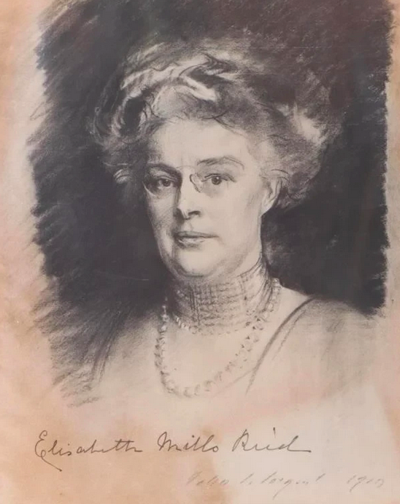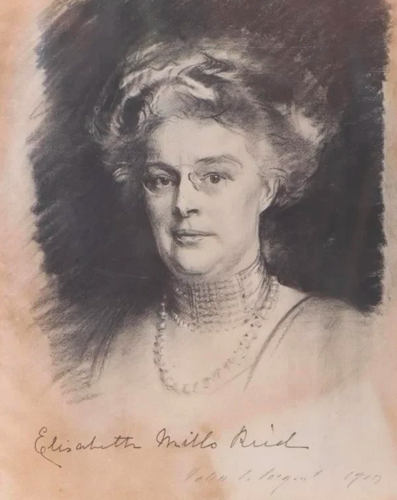Elisabeth (Lizzie) Mills Reid, the woman who gave us Mills Hospital, was a daughter of great privilege. Her father, Darius Ogden (D.O.) Mills, a Gold Rush and Silver Rush banker, was at one time the richest man in California. Lizzie’s childhood was spent between New York (where she was born in 1858), the Mills’ 44,000-square-foot country home in Millbrae, and Paris where she attended school in her teens.
On one of the family’s visits to their Millbrae estate around 1879, Lizzie met her future husband, Whitelaw Reid, who was also visiting California at the time. Lizzie was 21. Reid, then a 42-year-old New Yorker, was twice Lizzie’s age. Reid, an Ohio native from humble beginnings, had made a name for himself nationally as a reporter during the Civil War, after writing a gripping and gruesome account of the Battle of Shiloh. The Union armies claimed victory, but it came at a high cost: It was the bloodiest battle of the Civil War to that date, with 23,000 casualties. Reid’s detailed account of it propelled him to national fame.
After the war ended, Reid, an ambitious and bright man, spun his wartime correspondent’s role into a position at Horace Greeley’s New York Tribune and eventually purchased the paper. As a major newspaper owner and editor, he was expected to weigh in on political matters and he became active in Republican affairs. When the Mills family returned to New York in late 1880, the budding relationship between Whitelaw and Lizzie that had begun in Millbrae the prior year, accelerated quickly, albeit privately. According to Reid’s biographer, Bingham Duncan, Whitelaw “gave two consecutive theater parties to have the needed excuses to see her.” On Christmas Eve in 1880 he took Lizzie to the opera. The following day, she sent him a Christmas card “featuring a painted sprig of mistletoe with the message, ‘I surmount All Difficulties.’” By the beginning of 1881, they were engaged. D.O. Mills did not approve of the relationship, putting Whitelaw in the awkward position of asking friends to deny the engagement for several weeks. But by early February, Mr. Mills “had capitulated” and consented to the marriage. Lizzie wrote Whitelaw, “Of course I cannot flatter myself that my parents are wildly delighted, but we will make them so in time.” On April 26, 1881, approximately 250 people witnessed the wedding at Lizzie’s parents’ Fifth Avenue mansion.
For the next 30 years, until Whitelaw’s death in 1913, they were the consummate power couple, combining the enormous wealth of the Mills family with Reid’s role as a Republican powerbroker and newspaper man. During this time, Whitelaw served as ambassador to France (1889-92), ran as vice president in President Benjamin Harrison’s unsuccessful campaign to win a second term in 1892, and served as Ambassador to the Court of St. James (i.e. the United Kingdom) from 1905 until his death in 1912. During this time, the parties that the Reids threw were legendary. Yet Mrs. Reid never forgot the concept of noblesse oblige that her father had instilled in her.
While the Reids were in Paris, she developed an interest in helping women artists. Many American artists were in Paris at the turn of the 20th century, and her interest in art may have been spurred by her personal acquaintance with some of them. John Singer Sargent was confirmed in the same class as Lizzie in 1872 at the American Cathedral of the Holy Trinity in Paris. Later, he would make a charcoal sketch of her, as he did of so many wealthy women. During World War I, a Parisian building Lizzie had bought to house and exhibit the work of women artists was repurposed for use by the Red Cross, another group that she generously supported throughout her lifetime. After the war, due to the influence of college-educated women like her daughter-in-law Helen Rogers Reid, the building became the home of the American Women’s University Club. By 1928, it was known as Reid Hall. In 1964, Helen Rogers Reid, the widow of Mrs. Reid’s son, gifted Reid Hall to Columbia University.
Lizzie Reid’s mother, Jane Templeton Mills, died in 1888 at the age of 56 after a long-lingering illness. Her mother’s illness may have inspired Lizzie’s other charitable interest: health care. After her mother’s death, Lizzie traveled frequently with her widowed father. She particularly liked to accompany her father on his visits to Millbrae, his California estate, as she had many friends in California from the time she had spent there as a girl. She was a cousin to Ansel Mills Easton and Jennie M. Crocker and a friend of Maud Bourn Vincent, the only daughter of Filoli builders Agnes and William Bourn (In fact, Maud died of pneumonia in New York City in 1929 when she was returning to California from her Muckross Estate in Ireland. The funeral was held at Lizzie’s New York City home).
When another California friend, Abigail Parrott Payson, lost two children due to inadequate health care, Lizzie approached the rector at St. Matthew Episcopal Church about the need for medical care in the area. That conversation was the beginning of Mills Hospital. Lizzie was a lifelong Episcopalian and her family generously supported St. Matthew Episcopal Church, so when she went to the rector, he listened. On May 7, 1907, the San Mateo Leader reported architect Willis Polk was drawing up plans for a medical facility, and, pending its completion, a temporary dispensary would be set up in the parish house of St. Matthew Episcopal Church. The first name for the institution was “the Church of St. Matthew Red Cross Guild,” although it wasn’t formally associated with either the church or the Red Cross. Later, the hospital’s name was changed to The Church of St. Matthew Mills Memorial Hospital, in honor of Lizzie’s parents. Later still, it simply became known as Mills Hospital. A new 50-bed Louis Hobart designed building was completed in 1914, and another wing with an additional 124 beds was completed in 1928, but Mrs. Reid resisted attempts to expand the hospital further. She hoped that the 1928 addition would be the last — it was not — as she wanted to retain a personal, homey touch at the hospital. Until 1960, the table in the staff dining room was still set with linen tablecloths and silver. Mrs. Reid made annual trips to inspect the hospital and its services.
Darius Ogden Mills died from a heart attack at his Millbrae estate in 1910, leaving an inheritance of approximately $60 million to Lizzie and her brother Ogden Mills (over $2 billion today). The estate included the mansion in Millbrae and its surrounding 1,500 acres. Lizzie’s husband died in 1912, also from a heart attack. Lizzie’s brother Ogden died in 1929, followed two years later by Lizzie’s death in 1931.
Not long after her death, Lizzie’s nephew sold the family’s private airstrip to the city of San Francisco, leading to its development as San Francisco International Airport. The 44,000-square-foot Mills mansion remained standing near what is now the intersection of Murchison and Sequoia avenues until 1954, when it was destroyed by fire.
Joanne Garrison serves on the board of the Burlingame Historical Society. She is the author of “Burlingame Centennial: 1908-2008” and a website called Burlingame Founding Families.


























(0) comments
Welcome to the discussion.
Log In
Keep the discussion civilized. Absolutely NO personal attacks or insults directed toward writers, nor others who make comments.
Keep it clean. Please avoid obscene, vulgar, lewd, racist or sexually-oriented language.
Don't threaten. Threats of harming another person will not be tolerated.
Be truthful. Don't knowingly lie about anyone or anything.
Be proactive. Use the 'Report' link on each comment to let us know of abusive posts.
PLEASE TURN OFF YOUR CAPS LOCK.
Anyone violating these rules will be issued a warning. After the warning, comment privileges can be revoked.